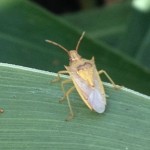The Stink Bug is a primary insect pest of grain sorghum from bloom until hard dough. The insect feeds directly on the seed, reducing seed weight and yield. The most common stink bug in grain sorghum of the Mid-Coast is the Rice Stink Bug.
Scout sorghum after bloom using a small bucket and beat heads into the bucket and see what is being captured in the bucket. Look here for a brief video.
 Economic thresholds (ET) have been evaluated and can be determined using tables or equations, but this can be challenging as it requires the grain value, cost of control and number of heads per acre. To add to the difficulty, the ET changes at the crop matures. The milk stage of maturity is the most sensitive to stink bug feeding.
Economic thresholds (ET) have been evaluated and can be determined using tables or equations, but this can be challenging as it requires the grain value, cost of control and number of heads per acre. To add to the difficulty, the ET changes at the crop matures. The milk stage of maturity is the most sensitive to stink bug feeding.
To simplify this process, start by using the following treatment thresholds. (assuming 60,000 heads per acre)
- bloom 1 stink bug per head
- milk stage 0.2 per head (1 bug per 5 heads)
- soft dough 2 per head
Control options for rice stink bug includes dimethoate, chlorpyriphos, and carbaryl. Pyrethroid insecticides have been recommended in the past and may be effective, however, check behind pyrethroid applications as field failures have been reported in the past few years.
More Information:
